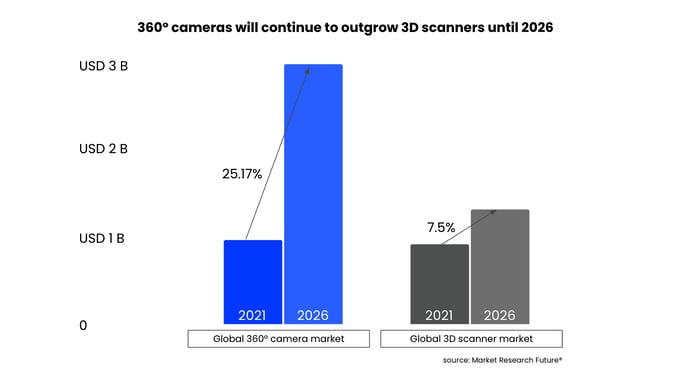This article is the start of a weekly series about what it takes to create a digital twin. This week, we are tackling what instruments are needed to capture a physical space. Can you create digital twins without fancy and expensive equipment like 3D scanners?
3D Scanners, a thing of the past
Capturing an image with an ordinary camera will give you a 2D representation of the scene. However, a 2D image cannot convey depth, distance, or context. To do so, you need to capture your scene in 3D.
From as early as the 60’s, there was already a drive to capture more immersive and contextual content with the first 3D scanners. The initial technology was limited, expensive, and complicated to use, making adoption difficult. However, even today, owning a 3D scanner or knowing how to use it has not been democratized. For instance, handling point cloud data from a LiDAR scanner to render a 3D model needs technical expertise and expensive equipment. Therefore, creating 3D models is still perceived as a costly, time-consuming, and daunting process, far from becoming a standard.
At Beamo, we strive to democratize the power of capturing spaces in 3D. As a matter of fact, Beamo makes it simple for anyone to create what we call a digital twin using only a smartphone and a 360° camera. With the software and hardware DIY digital twin solution offered by Beamo and the mass adoption of modern smartphones and 360° cameras, we are able to create a new standard that is both accessible and affordable.
Leading market analysis companies expect the global 360° camera market to quickly outgrow the 3D scanner market with a projected USD 2,993.6 million market value with a CAGR of 25.17% from 2020–2026 (forecast period). In comparison, the 3D scanner market was only valued at USD 924 million in 2021 and is projected to reach USD 1,324 million by 2026; growing at a CAGR of 7.5% from 2021 to 2026.

3D Origami for buildings - The Digital Twin
The digital twin technology is not a new concept. It has had many applications since its debut in the 60's with NASA developing its own assets to simulate conditions on board Apollo 13. Today, digital twin technology is used across many other industries including transportation, energy, manufacturing, construction, and facility management.
When creating a 3D digital twin with Beamo, users upload 2D panorama images taken from their smartphone or 360° camera. These images get processed, indexed, and rebuilt into a 3D digital twin using our machine learning visual cortex called Beamo.ai. Essentially, panorama images are first sliced into pieces and then stitched together in a way that represents a 3D space. It is the same concept as an origami, a traditional oriental technique of folding a flat piece of paper into a variety of 3D representational forms. Except here, the folding is not manual but automated and the result is the famous 360° sphere.
If a picture is worth a thousand words, a digital twin is worth a thousand pictures.
Seems pretty straightforward? Well, as the meme goes, expectations are not the same as reality. Tune in again next week as we take on the many challenges of 3D reconstruction from 2D images and how we were able to overcome them.